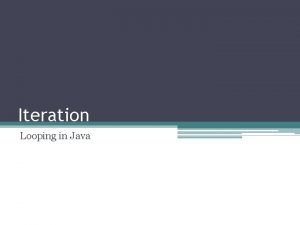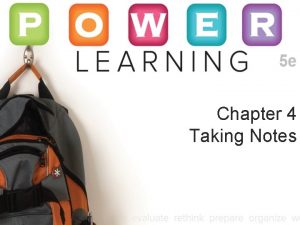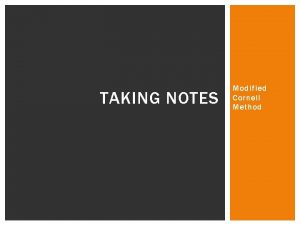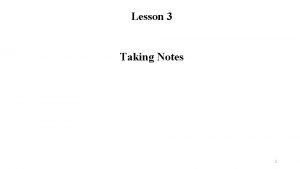NOTES ON NOTES Taking notes in class can











- Slides: 11

NOTES ON NOTES Taking notes in class can be a very helpful tool for students. However, there a number of different note taking systems to choose from and you may like one system more than another. The following are a number of examples: (NOTE: The first 4 formats use most of the same information in 4 different note taking styles

“The Paragraph Format” Form of taking notes -- form is important provides organization, major points, minor points, relationships, details. * “Paragraph form” -- easiest, poorest, write until idea changes, then begin a new paragraph. *”Sentence Form” -- more difficult than Paragraph Form, better series of numbered statements. *”Standard Outline Form” -- best for organization, most difficult; uses Roman numerals, letters, numbers, indentation to show organization. Notes for your guidance. *”Dash Outline Form” -- also like “Standard Outline”, but uses dashes instead of symbols; good organization, simple. Preferable: “Standard Outline. ”

. • “The Sentence Format” The form of taking notes is important. It provides organization by showing major point, minor points, their relationship to each other, and details. The “Paragraph Form” is the easiest to use and the poorest. For the paragraph form you write as a paragraph until the idea changes. • The “Sentence Form”, a little more difficult and a little better, is a series of numbered statements. • The “Standard Outline” form is the best organization and the most difficult to follow. It uses Roman numerals, letters, numbers, and various types of indentation. • • Remember that notes are for YOUR guidance only. So choose what YOU like best!

Dash Outline Format • -- Form of taking notes -- important because it provides organization -- major points, minor points, relationships between them, details • -- “Paragraph form” -- easiest, but poorest -- write until idea changes; begin new paragraph • -- “Sentence form” -- more difficult -- series of numbered statements • -- “Standard outline” form -- best for organization, but most difficult

Standard Outline Format I. Form of taking notes A. Form is important 1. Focus On: facts that relate to subheading 2. You could use lower case letters (a. & b. for example) B. Form provides organization 1. Main fact/detail 2. Main fact/detail II. Comparison of forms A. “Paragraph form” 1. Easiest 2. poorest B. “Sentence form” 1. more difficult 2. better C. “Standard outline form” 1. best organization 2. most difficult

OUTLINE FORMAT (A VARIATION – WITH A MORE DETAILEDEXPLANATION) The following example uses an excerpt taken from the Prentice Hall Earth Explorer's Earth Science text book (http: //educatoral. com/outline_format. html) I. Tools of Modern Astronomy A. Electromagnetic Radiation 1. Patterns in the sky are called constellations. Stars in constellations form shapes that we give names and patterns to. 2. Types of Electromagnetic Radiation i. The light we see is called visible light and light is a form of electromagnetic radiation. That is energy that can travel through space in the form of waves. ii. Many objects other than light also give off radiation.

B. Telescopes 1. "Most telescopes collect and focus different types of electromagnetic radiation, including visible light. " (p. 716) 2. Visible Light Telescopes i. Refracting telescopes uses convex lenses. Convex lenses are curved in the middle so the middle is thicker. 3. Radio Telescopes i. Radio telescopes detect radio waves from objects in space. They have curved, reflecting surfaces which focus radio waves the way a mirror in a reflecting telescope focuses light. 4. Other Telescopes i. There are telescopes that detect infrared radiation, ultraviolet, X-rays, and gamma rays.

II. Characteristics of Stars A. Distance to Stars i. I'll summarize galaxy and universe here, from page 723, as well as the info under Distance to Stars. Then I will proceed exactly like I did above for the section. Section 3 will be Roman Numeral III and so on. ii. This is how an outline looks for notes.

CORNELL FORMAT (A VARIATION CALLED “Q NOTES”) • The strict Cornell Format, created by Walter Pauk from Cornell University, may be too complicated for our use. You may want to try it when you attend high school and college.

Steps: • First it is suggested that you use a binder – not a spiral notebook – just in case you need to additional papers - may be a packet? • Then you make a line down the left side of your paper. This is the “Cue” column on the diagram. • In this column you turn your sub headings into questions. For example, (C. 4, L. 3 – p. 85) “NEW RULERS IN EGYPT” becomes WHO WERE THE NEW RULERS IN EGYPT? • You answer use sub-heading question in the “Note. Taking” area of your paper using bullets. * In the “Summaries” section at the bottom of each note page summarize the main ideas in your own words.

Or you could choose to take your notes like Leonardo da Vinci – combining written notes and pictures!
 In greenfoot, you can cast an actor class to a world class?
In greenfoot, you can cast an actor class to a world class? ødeficiency disease can be prevented by taking a -------.
ødeficiency disease can be prevented by taking a -------. Minion note it
Minion note it I hate taking notes
I hate taking notes Today's class
Today's class Package mypackage; class first { /* class body */ }
Package mypackage; class first { /* class body */ } Abstract class vs concrete class
Abstract class vs concrete class Mode grouped data
Mode grouped data Class i vs class ii mhc
Class i vs class ii mhc Difference between abstract class and concrete class
Difference between abstract class and concrete class How to find class boundaries
How to find class boundaries Sd and sdelta
Sd and sdelta





















